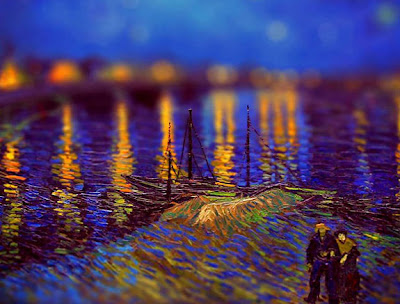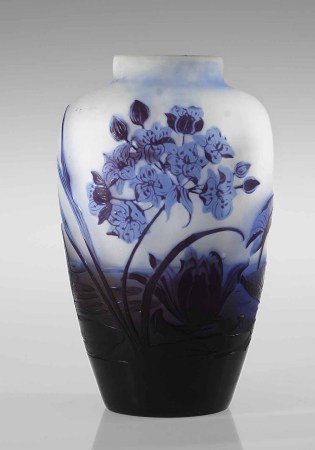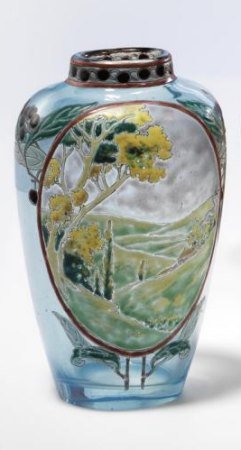In my last blog post I argued that
Jan Toorop’s Javanese roots influenced his art. Now I would like to point out another influence from the Dutch East Indies that impacted on Dutch Art Nouveau - batik. No one quite knows when the craft of batik began, though the word was already recorded in a 17th century Dutch shipping list. By the late 18th century, with the availability of high quality Indian cotton, batik was flourishing on Sumatra and Java and many of the other 13,000 islands that made up the Dutch colony, the Netherlands East Indies. Sir Thomas Stamford Raffles amassed a large collection of textiles, including batik, during his time on Java between 1811 and 1815. His collection is today in the British Museum. By 1845 colonial Dutch women had started their own workshops in the East Indies in which local women produced batik textiles that had been designed especially for the European market, featuring Indonesian, Chinese and European motifs. By the end of the 19th century some of these works were appearing at international exhibitions and in 1903 The East West Society founded a shop in The Hague, the Boeatan, which sold a variety of traditional Indonesian crafts, including batik. The shop would remain in business until 1971.
Although colonial relations were, by and large, characterized by inequality, John MacKenzie has argued that the area of design constitutes a field in which European-Asian relations were most often based on admiration, rather than subjugation, and that European attitudes towards Asian decorative arts were more affirmative than in any other area of culture.
Marjan Groot claims that the popularity of batik was “the most notable result of the early artistic interest in the Dutch colonies” and that in the nineteenth century “this admiration became embedded in arguments to reform Western decorative art and design”.
 |
| Agathe Wegerif-Gravestein in batik dress: 1902 |
Around 1892 Dutch artists began to experiment with applying batik to modern design. In 1898 a gallery opened in The Hague called Arts and Crafts and during its short lifetime (it went bankrupt after six years) quickly established itself as the premiere establishment of Dutch Art Nouveau decorative arts. That same year Agathe Wegerif-Gravestein (1867-1944), wife of the gallery’s financial backer, established the Arts and Crafts gallery batik workshop in the town of Apeldoorn. Wegereif often wore batik dresses, which provided her with a reputation for exoticism. Within two years over two dozen Dutch women were employed in her batik workshop and some of their products were exhibited in Paris at the 1900
Universal Exhibition, including textile furnishings for the Dutch pavilion. Marjan Groot has described Wegerif’s upholstery pieces as featuring “a fine linear Art Nouveau style”. Though her batik work spread throughout Europe, and was praised by female critics, as one of the few female artists in the Art Nouveau movement her creations were taken less seriously by male critics. They frequently condemned her work as too expressive and lacking a rational, that is, Dutch, approach.
 |
| Bench with batik upholstery by Agathe and Chris Wegerif-Gravestein: 1904 |
Agathe Wegerif freely admitted that she had been drawn to batik through conversations with the Dutch artist Johan Thorn Prikker. Most of her batik creations were based on Thorn Prikker’s designs. He himself had begun to work with batik in the early 1890s. Like Jan Toorop, he worked with the Belgian group Les XX, and became a close acquaintance of Belgian designer Henry van der Velde. Today van der Velde is remembered as one of the greatest exponents of Art Nouveau and many major museums are proud to exhibit his work, but Thorn Prikker has been all but forgotten. This chair was designed by van der Velde in 1893, but the batik upholstery is from Thorn Pikker.
 |
| Van der Velde chair with batik design by Thorn Prikker: 1893 |
That same year Thorn Prikker produced his best known painting, “The Bride”, which became famous briefly for its mystical atmosphere and the exotic, batik design of the woman’s dress.
 |
| The Bride by Johan Torn Prikker: 1893 |
In a poster for an exhibition of Dutch art in Krefeld, Germany in 1903 Thorn Prikker combined motifs from the Irish medieval
Book of Kells with tulip-like forms and shapes from Javanese batik textiles, demonstrating that what was unique about Dutch Art Nouveau was the typical Dutch restraint and symmetry combined with its colonial exoticism.
 |
| Batik Curtains designed by Thorn Prikker for Arts and Crafts, The Hague: 1900 |
 |
La Maison Moderne in Paris with batik designs from Thorn Prikker
|
 |
| Fragment of batik curtain designed by Thorn Prikker |
Another area where the influence of Indonesian batik made itself apparent in Holland was in book design. Carl Adolph Lion Cachet (1864-1945) was a famous Dutch Art Nouveau artist and the first to apply batik technique on parchment. To commemorate the inauguration of Queen Wilhelmina in 1898 he designed the catalogue of an exhibition of Royal Portraits and objects that had been held at the Rijksmuseum. Thirty-nine copies were bound in Lion Cachet’s beautifully designed batik parchment, to be presented to the new queen and other dignatories. Recently
a very lucky collector (and
blogger) stumbled across one of these in a second-hand bookstore and bought it for……. 14 euros.
 |
| Carl Adolph Lion Cachet's Catalogue of Exhibtion: 1898 |
In 1900 Louis Couperus, considered by many to be one of the greatest Dutch novelists, published his novel
De Stille Kracht (
The Hidden Force). The cover of an earlier novel,
Metamorfoze (1897) had had a beautiful Art Nouveau cover designed by Jan Toorop.
 |
| Cover design by Jan Toorop: 1897 |
De Stille Kracht was not only set in the Dutch East Indies (Couperus had spent most of his youth in the Dutch East Indies) but the book itself was designed by an important Art Nouveau artist, Chris Lebeau (1878-1945) and he had the cover executed in the Indonesian batik technique.
 |
| Chris Lebeau's batik cover design for De Stille Kracht |
Today the Wolfsonian library of the Florida International University has an unrivalled collection of Dutch Art Nouveau bookbindings and ornamental ephemera that are distinguished by themes, motifs and techniques, such as batik, that were introduced from the Dutch East Indies. Some of the leading Dutch artists of the late 19th and early 20th centuries are included in the library’s collection, including Jan Toorop, Carl Adolph Lion Cachet and Chris Lebeau.
 |
| One of the hundreds of the batik bookbindings in the Wolfsonian Collection |
In 1901 Johan Thorn Prikker and Henry van der Velde worked together on a magnificent house called “De Zeemeeuw” (“The Seagull”) in Scheveningen, just outside The Hague. Van der Velde designed the house while Thorn Prikker decorated the interior. He painted a huge mural above the staircase "The Game of Life" based on a Hindu story.
 |
| Johan Thorn Prikker, The Game of Life: 1901 |
But by 1904 Johan Thorn Prikker found himself to be
persona non grata in the Dutch artistic world. Artistic and political differences had caused him to fall foul of the leading practitioner of modernism in the Netherlands, the architect H. P. Berlage. In Holland Thorn Prikker had worked in an amazing variety of media, producing paintings, murals, lithographs, furniture, carpets, lamps and textiles, including batik. He had been one of the first to apply the traditional Indonesian batik technique in contemporary art, in textiles and in painting, had contributed to a renaissance in Dutch bookbinding and he had inspired Agathe Wegerif-Gravestein to found the first batik workshop in Europe. Thorn Prikker left for Germany, where he would spend the rest of his life, as creative as ever. In Germany his work was valued, he would hold a number of professorships in art and design colleges and he was recognized as the most important master of modern stained glass art. But in his native Holland he faded from memory and hardly gained a mention in English or French histories of art, despite the fact that nearly all major Dutch and German museums possess work of his.
But Johan Thorn Prikker is being reclaimed. In 2008 a German art historian by the name of Christiane Heiser was awarded a PhD by the Dutch University of Groningen for her work on Thorn Prikker’s artistic biography. Now she has helped curate a large exhibition in Rotterdam’s
Museum Boijmans van Beuningen. But you will have to be quick, the exhibition finishes tomorrow. Then it will travel to Düsseldorf where it opens on March 26th at the
Kunst Palast and runs to August.































+++Cutting+Origami.jpg)
+Blue+Kimono.jpg)
+A+Woman+in+a+Japanese+Bath.jpg)
+Chinese+Coat.jpg)

+++Japanese+Print+1898.jpg)
,+Girl+in+Blue+Kimono.jpg)
+++The+Japanese+Book+1900.jpg)
+++The+Kimono+1895.jpg)
++Blue+Kimono+1798.jpg)
++Girl+in+a+Japanese+Kimono.jpg)
++Peonies+1897.JPG)
++Study+of+a+Girl+in+a+Japanese+Dress.jpg)
++The+Black+Kimono.jpg)
++Woman+in+Kimono+Holding+a+Japanese+Fan.jpg)
++Making+Her+Toilet+1892.jpg)














